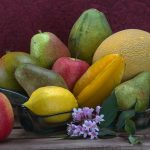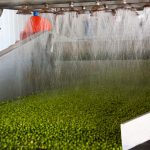
Fruit ripening is a feature of nature, a biochemical process by which produce becomes acceptable for consumption and bestows its nutritional benefits when consumed. One of the consequences of ripening is that fruit becomes softer and sweeter to the taste which helps its appeal. One of the reasons for such sweetness is that during ripening starch is converted to sugars such as fructose. From the sensory perspective the fruit is ripe when its colour has become appealing, has full flavour and aroma.
Fruits are classified according to their ripening behaviour. They may be defined as:
- climacteric
- non-climacteric
Climacteric Fruits
Climacteric fruits are those which show a dramatic increase in the rate of respiration during the ripening process. Ripening often occurs when they are exposed to the gas ethylene which promotes ripening. Typical fruits are bananas, apples, figs, papaya, guava, pears, plums, tomatoes and mango.
Non-Climacteric Fruits
These are fruits which do not ripen further once they have been harvested.
Non-climacteric fruits are those such as grapes, cherry, strawberries, watermelon, pineapple and the citrus fruits. These do not show a dramatic increase in the rate of respiration during their ripening. They are not affected by the presence of ethylene.
To obtain a full ripeness and flavour, these fruits are harvested once they are fully ripe rather than picking before they are known to be ripe.
What Changes Can Be Expected During Ripening
Various parts of the fruit and a number of molecules are affected. These include:
- cell walls are weakened
- starch degradation
- changes in organic acids
- changes in colour as pigment distribution is altered
- production of flavouring compounds
- production of vitamin C (ascorbic acid)
- changes in phenolics, amino acids and proteins
- increases in respiration
- changes in water transpiration
- alteration in ethylene evolution rate
The Process Of Ripening
An unripe fruit such as a green banana produces ethylene which is the simplest carbon compound to contain a C-C double bond. It induces or turns on various genes involved in enzyme synthesis which are involved in the degradation of various parts of the fruit so making it ready for ripening. Various biochemicals are affected during ripening – starch conversion has already been mentioned but chlorophyll, various acids, pectins and proteins are all involved. The affect on the ripening fruit is to induce the creation of more ethylene which positively induces further changes in ripening.
The Biochemical Synthesis of Ethylene
The amino acid methionine is converted to adenosylmethione, catalysed by the enzyme AdoMet Synthetase using ATP. A second synthetase (ACC Synthase) converts this molecule to ACC (amino cyclopropane carboxylic acid). The third enzyme ACC Oxidase converts ACC to ethylene in the presence of oxygen.
Changes To Pigments During Ripening
During the ripening process ethylene activates and promotes the degradation of chlorophyll during maturation.
Changes To Cell Walls
The cell walls in fruit are rich in polysaccharides such as pectin. These are broken down catalysed by the action of enzymes. These polysaccharides become more solubilized as they are broken down. There is a loss of neutral sugars such as galactose and arabinose. The enzymes which cause cell wall break down are:
- polygalacturonase
- pectinesterase
- cellulases
- beta-galactosidase
Control Of Ripening
Methods to control ripening are very important in managing the supply chain of fruit. Any improvements in extending or reducing shelf-life are important. How many instances have we tried to eat a ready-to-eat avocado only to find it is as hard as stone.
One particular method is to regulate the temperature.
If the temperature is increased, the rate of ripening increases. So storage at lower temperatures – just above freezing helps delay this particular process. Storage at chill temperatures is important immediately as soon as the fruit is harvested. It reduces the rate of respiration and drops ethylene production.
If the fruit is stored below the optimum for storage then it suffers cold injury and produces spoilage.
The control of ethylene production is highly important in delivering fruit of suitable quality to the retailer. If we can control ethylene levels to some extent within packaged foods we can minimise the deterioration in fruit quality and even stop product decay.
A very important chemical used to block the action of ethylene is 1-MCP (1-methyl cyclopropene).
There are some excellent reviews which should be consulted regarding fruit ripening (Brady, 1987). One covers the influence of ethylene in this process (Lelièvre et al., 1997).
Potassium permanganate is a highly effective ethylene gas scavenger and so has been useful in active packaging. Even in the 70s the idea of potassium permanganate was being pursued. Scott et al., (1970) used this agent in sealed polyethylene bags of green bananas to add an extra two weeks of storage life. To a supplier, two weeks is a life-time and so putting a stopper into death to keep fruit fresh comes as an enormous economical advantage.
The mechanism of action is through a reaction of ethylene with permanganate that is a classic oxidation and reduction reaction. Water and carbon dioxide are produced. Increasing the level of carbon dioxide blocks the synthesis of ethylene by the produce which is the means by which ripening is controlled.
One recent study to be reported at the IFT meeting in July 2024 assessed the use of potassium permanganate as an indicator of fruit quality. The objective here was to study he freshness of bananas and kiwifruit which ripen very quickly in the presence of ethylene (Kim & Min, 2024). The indictor can detect decay by monitoring levels of ethylene based on the degree of colour change from purple to brown.
References
Brady, C. J. (1987). Fruit ripening. Annual Review of Plant Physiology, 38(1), pp. 155-178 (Article)
Kim, B.Y., Min, S.C. (2024) Application of an Ethylene Indicator Using Potassium Permanganate to Monitor Freshness of Banana and Kiwi. IFT Poster 2024 Chicago.
Lelièvre, J. M., Latchè, A., Jones, B., Bouzayen, M., & Pech, J. C. (1997). Ethylene and fruit ripening. Physiologia Plantarum, 101(4), pp. 727-739 (Article)
Scott, K. J., McGlasson, W. B., & Roberts, E. A. (1970). Potassium permanganate as an ethylene absorbent in polyethylene bags to delay ripening of bananas during storage. Australian Journal of Experimental Agriculture, 10(43), pp. 237-240



Leave a Reply